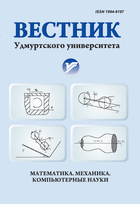Все выпуски
- 2025 Том 35
- 2024 Том 34
- 2023 Том 33
- 2022 Том 32
- 2021 Том 31
- 2020 Том 30
- 2019 Том 29
- 2018 Том 28
- 2017 Том 27
- 2016 Том 26
- 2015 Том 25
- 2014
- 2013
- 2012
- 2011
- 2010
- 2009
- 2008
-
В работе рассматривается вывод законов кинематического управления движением трехколесного и четырехколесного экипажей с жесткими колесами вдоль произвольной гладкой траектории. Параметрами управления для трехколесного экипажа выбраны независимые углы вращения ведущих колес. Параметром управления четырехколесного экипажа выбран угол поворота переднего колеса в двухколесной модели автомобиля, определяемый углами поворота передних колес по принципу рулевого управления Аккермана. Установлено, что произведение скорости любой точки корпуса автомобиля на ориентированную кривизну ее траектории является кинематическим инвариантом, определяющим угловую скорость автомобиля. Приведены результаты численного моделирования и анимации движения трехколесного и четырехколесного экипажей, демонстрирующие адекватность предлагаемой модели кинематического управления. Обсуждаются возможности применения установленных законов кинематического управления движением при уточнении алгоритмов параллельной парковки, при решении навигационных задач управления механическими транспортными средствами при помощи навигационных систем ГЛОНАСС и GPS, при решении задач управления мобильными роботами с помощью датчиков слежения, а также при проектировании автодорог, транспортных развязок, паркингов, автозаправок, дорожных пунктов питания и при создании тренажеров.
кинематическое управление, трехколесный экипаж, мобильный робот, траектория движения транспортного средства, углы поворота управляемых колес, принцип рулевого управления Аккермана, навигация, маневрирование
Kinematic control of vehicle motion, pp. 254-266The derivation of laws of kinematic control of motion of three-wheeled and four-wheeled carriages with hard wheels along an arbitrary smooth trajectory is considered in this paper. The independent angles of rotation of driving wheels are chosen as parameters of control for a three-wheeled carriage. The angle of rotation of a front wheel in the two-wheeled car models defined by the angles of rotation of front wheels on the basis of Ackermann steering is chosen as a control parameter for a four-wheeled carriage. It is established that the product of the velocity of any point of the vehicle body and the oriented curvature of its trajectory is a kinematic invariant determining the angular velocity of a vehicle. The paper presents the results of numerical modeling and animation of three-wheeled and four-wheeled carriages motion demonstrating the adequacy of the proposed model of kinematic control. The use of the proposed model can be a significant refinement of algorithms of parallel parking as well as the solution of navigation problems of management of motor vehicles using GPS and GLONASS navigation systems and problems of control of mobile robots with the help of tracking sensors. Also the proposed model can be useful for designing the motor roads, road interchanges, single-level and multilevel Parking lots, gasoline stations, on-the-go fast food stations and for the creation of car-simulators.
-
Рассмотрена задача оптимального управления движением космического аппарата при коррекции его положения в инерциальной системе координат за счет управляющих моментов, получаемых от ускорений инерционных маховиков бесплатформенной инерциальной навигационной системы. Полученное оптимальное управление обеспечивает плавное изменение ориентации космического аппарата, которое рассматривается как движение по кратчайшей траектории в конфигурационном пространстве специальной ортогональной группы $SO(3)$. Алгоритм управления реализуется с использованием оригинальной процедуры нелинейной сферической интерполяции кватернионов. Основными исполнительными органами ориентации динамического контура управления бесплатформенной инерциальной навигационной системой при решении задачи оптимального управления были выбраны четыре инерционных маховика (три - по осям космического аппарата, четвертый - по биссектрисе). Результаты моделирования верифицируются путем создания анимации корректирующего движения космического аппарата.
космические аппараты, бесплатформенные инерциальные навигационные системы, управляющие моменты, плавное движение
Optimal stabilization of spacecraft in an inertial coordinate system based on a strapdown inertial navigation system, pp. 252-259We consider the optimal control problem for spacecraft motion during correction of its position in an inertial coordinate system by means of control torques. Control torques arise from the acceleration of inertial flywheels of a strapdown inertial navigation system. We investigate optimal control, which ensures a smooth change in the spacecraft orientation. This smooth corrective motion is described as the motion along the shortest path in the configuration space of a special orthogonal group $SO(3)$. The shortest path coincides with the large circle arc of the unit hypersphere $S^3$. We also consider a control algorithm using the original procedure of nonlinear spherical interpolation of quaternions. Four inertial flywheels are used as the main executive bodies for orientation of the dynamic control loop of the strapdown inertial navigation system when solving the optimal control problem. Three flywheels are oriented along the axes of the spacecraft. The fourth flywheel is oriented along the bisector. The simulation results are presented. We consider examples for corrective motion in which the spacecraft has zero velocity and acceleration at the beginning and end of the maneuver. We give an animation of the corrective movement of the spacecraft. The proposed formalism can be extended to control the spacecraft motion at an initial angular velocity different from zero, as well as in the orbital coordinate system.
Журнал индексируется в Web of Science (Emerging Sources Citation Index)
Журнал входит в базы данных zbMATH, MathSciNet
Журнал включен в базу данных Russian Science Citation Index (RSCI) на платформе Web of Science
Журнал входит в систему Российского индекса научного цитирования.
Журнал включен в перечень ВАК.
Электронная версия журнала на Общероссийском математическом портале Math-Net.Ru.




